It is hard in the wake of the October 7 massacre to calmly contemplate Palestinian strategy and thinking. There is no Israeli unaffected, no one without family and friends reeling from the Hamas onslaught, no one, including this writer, not overcome with anxiety for relatives or neighbors now called up to the war.
And yet it is necessary. It is necessary to understand the enemy, the chain of rationalization and habits of mind that produced them and shaped their strategy of brutality.
That enemy is not the Palestinian people, of course, even though support for terror attacks is widespread among Palestinians. The enemy is not exactly Hamas either, though Hamas is part of it. The enemy is the Palestinian theory of Israelis that makes the violence seen on October 7 seem to many of them a rational step on the road to liberation rather than, as Israelis judge it, yet another in a long string of self-inflicted disasters for the Palestinian cause.
The October 7 massacre wasn’t an outlier in Hamas’s long history of brutality; it was its apotheosis. It was what Hamas would do if it could. On that dark Saturday it suddenly found that it could, and so it did.
But the unbelievable brutality displayed by the terrorists doesn’t mean the massacre was an emotional act. Palestinian terrorism is rarely chaotic and emotionally driven. The most horrifying examples of it, suicide bombings of the past or the rampage and mass kidnapping seen on Saturday, are carefully planned and deliberate acts.
The Palestinian strategy of terrorizing Israeli civilians is old, older even than the Israeli conquest of the West Bank and Gaza in 1967. When the PLO was founded in 1964 with the goal of driving the Jews from the country, the West Bank was still ruled by Jordan and the Gaza Strip by Egypt. The PLO adopted terrorism as the basic strategy for Palestinian liberation not in anger, but because it had just witnessed the astonishing success of the Algerian National Liberation Front in using such terrorism to drive the French from Algeria in 1962.
Illustrative: British troops carry protective shields at the ready as they advance on a crowd of Arab protestors during a riot in Jerusalem in June 1936. (AP Photo)
And it goes back further still. Organized Palestinian violence against the Jews in 1920, 1929, the so-called Arab Revolt of 1936-39 — all followed the same basic theory: The Jews are an artificial, rootless polity removable by sustained violence, so sustained violence must be deployed to remove them.
This Palestinian vision of Israelis is taught to Palestinian children as the basic truth of the Palestinian struggle. The contrast between “rooted” Palestine and “artificial” Israel is a major theme of Palestinian identity.
The consequences of this longstanding vision and strategy has been nothing short of shattering for Palestinians.
What do they want?
Supporters of the Palestinian cause in the West, even as they are discomfited by images of parents lying murdered in front of their children or the burned corpses of babies, are now asking a simple question in Hamas’s defense: “What would you do if faced with decades of Israeli occupation?” Israel’s policies in the West Bank and toward Gaza, and the pain and injustices that flow from them, they argue, are the cause of the kind of hatred on display on October 7.
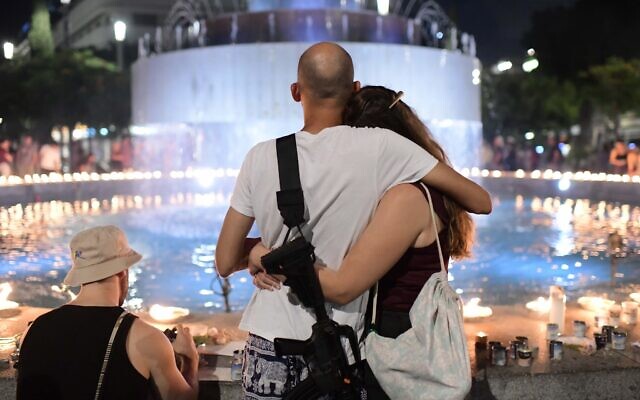
People gather and light candles at Dizengoff Square in Tel Aviv to remember the victims murdered by Hamas terrorists in southern Israel , October 14, 2023 (Tomer Neuberg/Flash90)
The problem for Palestinians — and it is a problem with immense consequences for them — is that the vast majority of Israelis disagree. They believe Hamas would have acted the same even if the occupation had ended two decades ago. This belief may seem self-serving to outsiders, but it’s rooted in deep and painful experience.
The fall of 2000 saw the start of a wave of some 140 suicide bombings in Israeli cities and towns, killing grandmothers and infants in buses and pizzerias and driving the political left from power so comprehensively that a generation later it has scarcely recovered.
The shattering effect of this mass murder wasn’t caused just by the shock and trauma of the attacks. It was also the timing.
In 2000, the peace process hadn’t yet seen two decades of stagnation. No far-right parties sat in the ruling coalition. Ending the occupation was an idea that won an election. Negotiators at Camp David were reported to be discussing shared Israeli-Palestinian sovereignty on the Temple Mount. There were no Israeli soldiers in any Palestinian city or town — they’d been pulled out over the previous three years — and Palestinian incomes and college education rates were rising. Things seemed to be falling into place. Peace, many Israelis assumed, was imminent.
The political left had also fought what amounted to an internal political civil war to get to that point, seen its leader assassinated and eked out a hard-won victory in the 1999 election to finish the job of peacemaking, and the result of its efforts was the most gruesome and sustained Palestinian assault on Israeli civilians in the country’s history.
So what was that massive, sustained terrorist wave about?
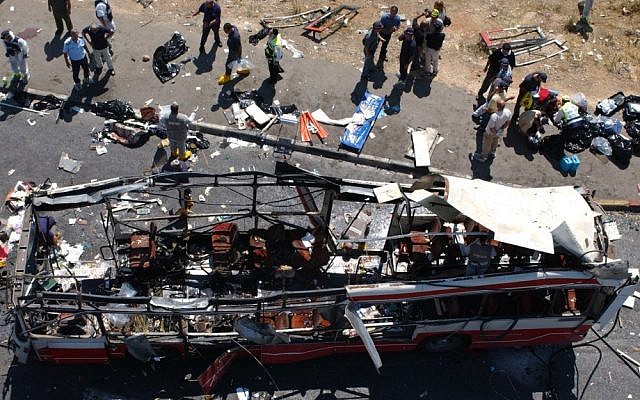
Police and paramedics inspect the scene after a suicide bomber blew himself up on a rush-hour bus near the Jerusalem neighborhood of Gilo during the Second Intifada, on June 18, 2002. (Flash90/File)
Palestinian explanations only heightened the anger. Palestinian officials went on Israeli television and told Israelis that the culprit was the visit to the Temple Mount by then-opposition leader Ariel Sharon shortly before the outbreak of violence. For the Israeli left, it was worse than no explanation at all. It amounted to telling left-wing Israelis that all their struggles and sacrifices for peace had stood on a foundation of dust and were demolished by the first act of right-wing political posturing that Palestinians found unpleasant. This spasm of killings, the Palestinian explanation implied, was inevitable.
Palestinian intellectuals have since offered better answers, including that the violence began as an internal Palestinian uprising against Yasser Arafat’s increasingly tyrannical regime in Ramallah, a kind of presaging of the Arab Spring in 2011, and was quickly deflected by a frightened Arafat into a campaign of terrorism targeting Israeli civilians.
But amid the bombings, few Israelis had the bandwidth to contemplate such complexities.
To them, it felt like all Palestinians had rallied to the murderous campaign. To recruit hundreds of suicide bombers (some 140 made it past the Israeli security services; a much larger number tried or made plans to), one needs an infrastructure of recruitment, a leadership that offers religious and social validation for the attacks, supply networks, laboratories and engineers to produce the bombs, a basic intelligence apparatus to help the bombers past Israeli security, along with bank accounts, safe-houses and the like.
And for what? The question has haunted and undermined the Israeli left for a generation.
Would an Israeli withdrawal from the West Bank have prevented Hamas’s attack on October 7? Israelis, still living in the shadow of that two-decade-old trauma, do not think so. They believe, truly and earnestly, including among liberal voters, that such a withdrawal would only have created a larger terror polity capable of launching a much larger rampage.
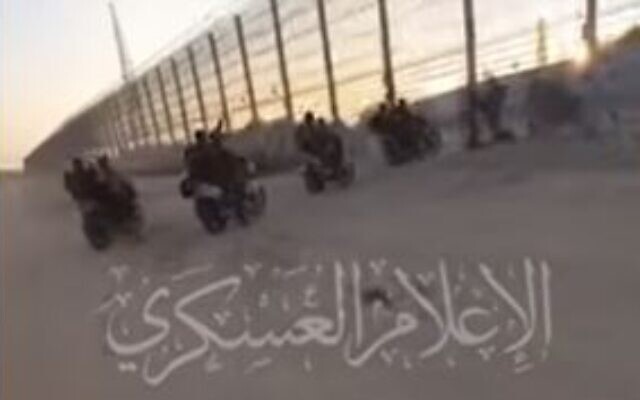
A Hamas video shows Hamas terrorists on motorbikes crossing the breached fence from Gaza into Israel on October 7, 2023. (Youtube screenshot)
And that Israeli belief is the Palestinians’ single biggest strategic problem, even if neither their leaders nor their overseas supporters are willing to acknowledge it.
This belief immunizes Israelis to outside pressure. If the response of Palestinian politics to the Oslo peace process was the mass murder of Israeli civilians, and the response of Palestinian politics to the stagnation of the peace process under Benjamin Netanyahu is the mass murder of Israeli civilians, then Israeli policy isn’t the cause of Palestinian mass murder of Israeli civilians.
Similarly, while overseas activists threaten Israelis with boycotts if they don’t leave the West Bank, Hamas threatens Israelis with murder from any territory they do abandon. Hamas is louder.
The point isn’t that this Israeli experience is the objective, comprehensive historical truth, but only that the vast majority of the Israeli Jewish mainstream believes it and that this belief is strong and rooted in blood-soaked experience. It has rendered Israelis immune to both foreign economic pressure and Palestinian violence.
In the Israeli mind, the Palestinian national movement seems set against itself. There is nothing the global campaign for Palestine can do in the Israeli psyche that Hamas’s brutality won’t undo.
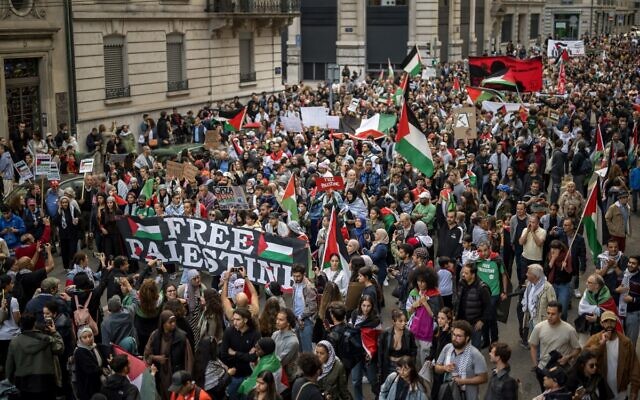
Protesters rally in support of Palestinians in Geneva, Switzerland, on October 14, 2023. (Fabrice COFFRINI / AFP)
Clarity
Then came Saturday, and the death of Israeli questions. For a moment, Israel’s guard went down. Hamas was free to live out its intentions. It did so with blazing clarity and purpose.
It is obvious to Israelis that Hamas’s brutal strategy cannot liberate Palestinians, so the violence can’t be explained to them as an attempt at liberation. Nor does Hamas bother to articulate its strategic rationale to Israelis, as Algeria’s FLN once did so clearly to the French. It asks them to flee or die, but can’t articulate where they should flee to.
Israelis are now convinced that the massacre on October 7, in its enormity and astonishing cruelty, and especially in the joy with which it was carried out, wasn’t a Palestinian miscalculation, because Palestinian independence wasn’t its goal.
The goal on October 7, as in the fall of 2000, was simply the complete removal of the Jews from this land.
With clarity comes closure. Israelis are unified as never before, and not just by the horrors perpetrated by Hamas. Their question is answered at long last. The brutality they once saw as a question turned out to be the answer, the purpose and end of much of Palestinian politics.
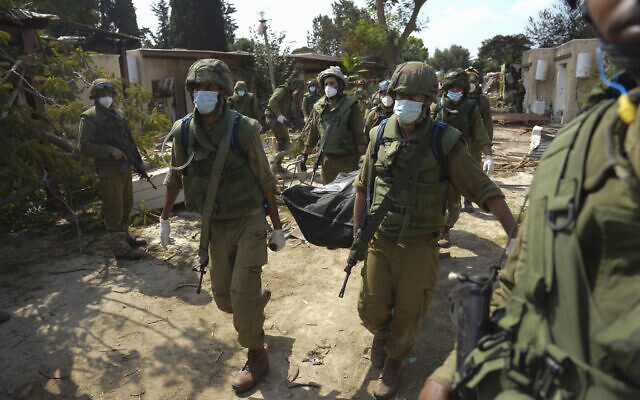
Israeli soldiers carry a body of a person killed in Hamas attack in kibbutz Kfar Aza on Tuesday, Oct. 10, 2023. (AP/Erik Marmor)
One can seek out the ideological roots of Hamas’s strategy of brutality in 20th-century decolonization movements or in theologies of Islamic renewal. But that history is mere background decor to the essential point — that this is a brutality that explodes against peace processes as much as against threats of annexation. No peace and no withdrawal will satisfy this impulse or grant Israeli Jews safety from the kind of wild, joyful hatred displayed on October 7.
And that brutality has now made itself too dangerous to be tolerated.
Hamas does not yet seem to realize how deep the Israeli public’s determination goes. Hamas’s only strategy for survival seems to be forcing the Israel Defense Forces to inflict so high a civilian toll in Gaza that the world demands a stop to the Israeli war machine.
But Israelis will be reeling from the images of October 7 for a long time to come. They have their answer, and from it flows a clarity of purpose that has been missing for the past three decades. The Israeli war machine will be implacable. Hamas will not survive.
A tragedy is about to unfold in Gaza made worse by the long learning curve it will take for Hamas to grasp the depth of Israeli resolve. It has robbed Israel of any other interest but its destruction. In the Israeli mind, any brutality Hamas can commit it will commit. And so it cannot be allowed to ever commit any act ever again.
And at the end of this long, dark path, this is, perhaps, the lone spark of optimism.
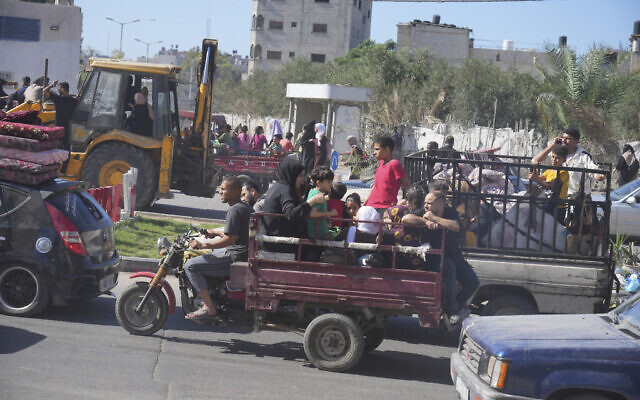
Palestinians flee to the southern Gaza Strip after the Israeli army issued an evacuation warning to a population of over 1 million in northern Gaza and Gaza City to seek refuge in the south ahead of a possible Israeli ground operation, Oct. 13, 2023. (AP Photo/Hatem Moussa)
When Hamas is destroyed, Israel will finally have liberated the Palestinian cause from the bottomless brutality of its most fervent practitioners, from the shattering albatross of a violent decolonization movement that refuses to grasp its enemy has no colonial motherland to which they can return, and so from an addiction to cruelty without purpose or function.
Western supporters of Palestinians will no longer be forced to justify the purposeful massacre of babies in their rush to protect the Palestinian national movement from itself. And Israeli critics of Israeli policy will be free to focus on Israeli misdeeds without having to answer for Palestinian savagery even and especially in times of peacemaking.
A brutalized, embittered Israel will finally liberate the Palestinians from their own wrecked vision of their cause and their enemy, not out of magnanimity but out of Israeli necessity and pain. Hamas’s destruction alone won’t bring peace, but perhaps it isn’t too optimistic to hope it can mark the end of Palestine’s long collapse.